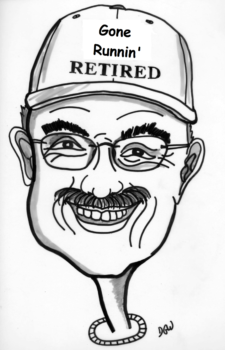A $150 marathon entry fee is a minor portion of your budget when participating in an out-of-town race. Not that spending $150 is insignificant. Airfare, food, and hotels for big-city races may run more than $1500. I smile when I see double-digit entry fees.
There are ways to reduce costs: early bookings, discount fares, and low-quality hotels. Cutting costs may reduce your comfort and impact your race performance.
My preferred mode of transportation to a race is driving. I’ll take that option if I can get to a race city within 12 hours (800 miles) of driving.
The advantages of driving include unlimited equipment and supplies, you are on your schedule, you are not around potentially sick people, and you don’t need to plan for ground transportation at the race site.
With a car, you can fill all the space to fulfill any possible need. I travel with a microwave and food. If you are unsure about the weather, you have room to carry clothes for ten degrees and snow and 80 degrees and sun. There is no problem packing four pairs of running shoes. You have space and no restrictions to carry full bottles of liquids and water.
The only time issues you need to worry about are picking up your bib and standing at the start line at the appropriate time. There may be a traffic backup, but you won’t need to hurry up and wait for a connection.
The driving costs include the wear on your body, the extended travel time, the impact on your car, and parking fees.
Even with adaptive cruise control, driving in a cramped car for 12 hours will impact your muscles. In a cramped airline seat, at least you can sleep.
If you still need to work, you may not have six days of vacation time available for travel and race activities.
Even with newer cars, putting 2000 miles on a vehicle will reduce its longevity. There’s the cost of gas, tires, and added maintenance. You may want to analyze the cost-effectiveness of using a personal vehicle versus a rental car.
You’ll need to park the car somewhere when you arrive. When I drove to downtown Deadwood, South Dakota, they wanted $10 for 2 hours. But it’s so easy when ParkMobile collects money for them.
For longer trips, flying may be your best option.
When flying, I don’t check the bag containing my running shoes or clothes. If I get to a race and have nothing to run in, it’s a wasted trip. Not only can a checked bag be delayed or lost, but there is also a possibility of stealing your carbon-plated shoes.
Now, I’m limited to two bags: one in the overhead compartment and a backpack for under the seat. Predicting race weather becomes critical to pack the right stuff in your limited space.
If you need to make a connection on the way to the race, ensure the time on the ground is at least two hours. Missing a connection may mean missing a race. There is no restriction on your flight home. Who cares if you miss a day of work?
Avoid connections when possible. Flying to Chicago and driving to Green Bay may be quicker than any possible connection.
I usually plan for three nights in the race city: one before packet pickup, one before and one after the race. Flying in on packet pickup day may mean missing the expo and cause unnecessary race morning stress.
If time is not an issue, explore the changes in airfare when flying on different days. Determine the difference between the extra day in a hotel and cheaper airfare.
I’ve had to take ferries to race locations. I’ve never taken a bus or train. These alternative modes allow you to carry more baggage but are more time-consuming than flying and don’t save on cost.
Once in the race city, consider the public transportation options: the subway in New York, the T in Boston, the L in Chicago, the light rail in Phoenix, and the buses in Vegas. These may help avoid rental car, cab, and ride-share expenses. If possible, walking is a good option.
Convenient lodging may be more expensive than remote hotels. If you can justify the expense, a hotel near the race venue will reduce race morning logistics. However, food options may be limited and costly.
I’ve picked one chain (Hilton) for my race travels. I’m part of their rewards program and know their locations’ quality, amenities, and safety. Rather than jumping chains, you will accumulate enough nights for extra benefits. For some of my remote races, I’ve made the hour drive on race morning rather than the potential issues with the local dive.
With the amazing internet, you can search for food options during your trip planning. With my food sensitivities, I’ll eat most of my prerace meals in my hotel room. Post-race, I’m not concerned.
Plan carefully for your race morning meal. Don’t worry about the complimentary breakfast buffet; you will probably be out the door before they start serving.
In-room coffee makers heat water for oatmeal. Pack whatever food you need for a good race.
You’re in a new city and want to see the sights. Remember, time on your feet before a race will impact performance. If you’re going to explore, spend the time after your race.
At my age, I will no longer book nonrefundable options. I’ll pay more for airfare and hotel rooms with 24-hour cancellation policies. Being in the race business, I know race entry fees are not refundable. So, I don’t ask.
Getting out of the burg for an adventure will expand your view of racing and be a training motivator. For the real race adventure, stay at grandma’s house.
